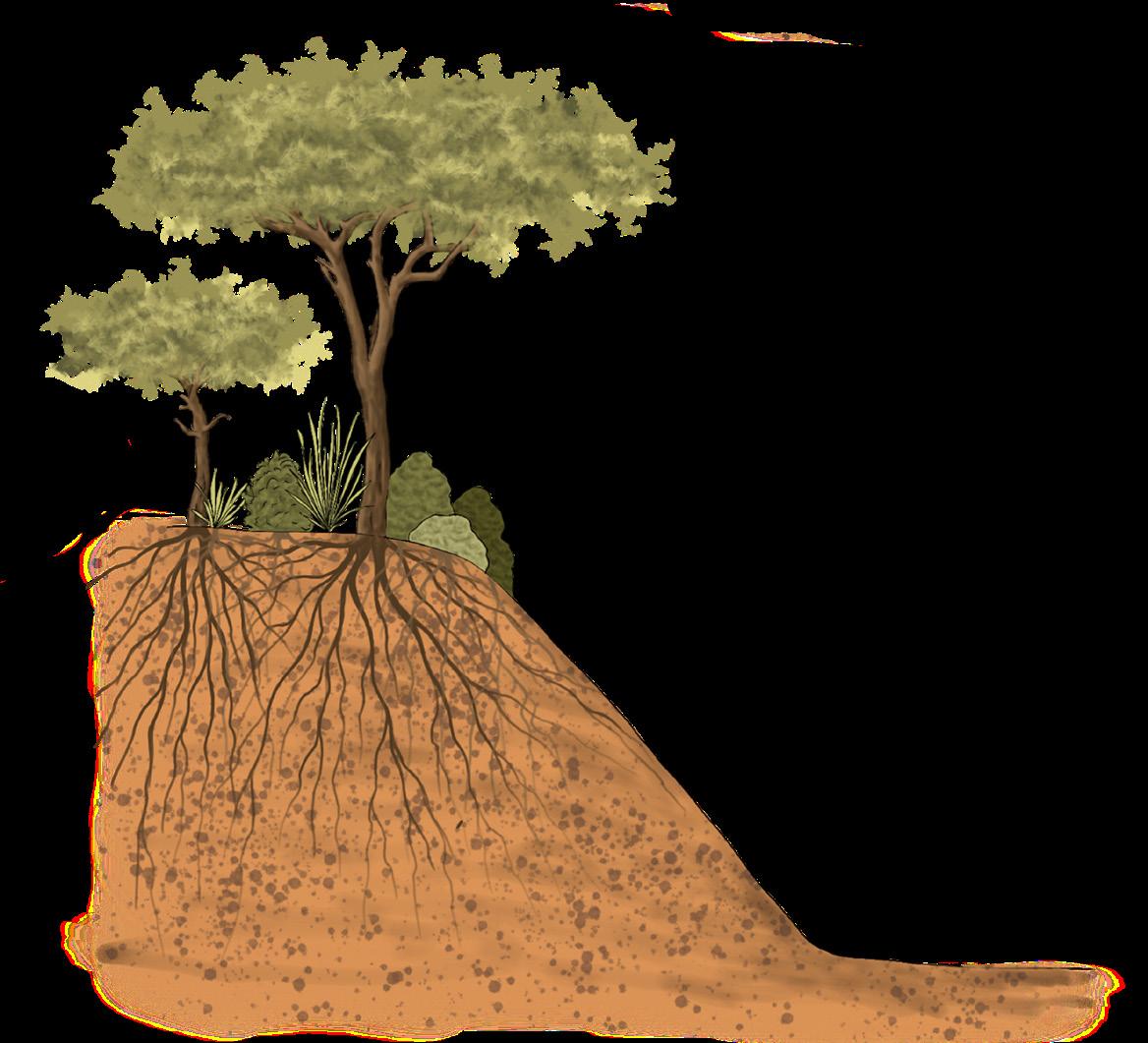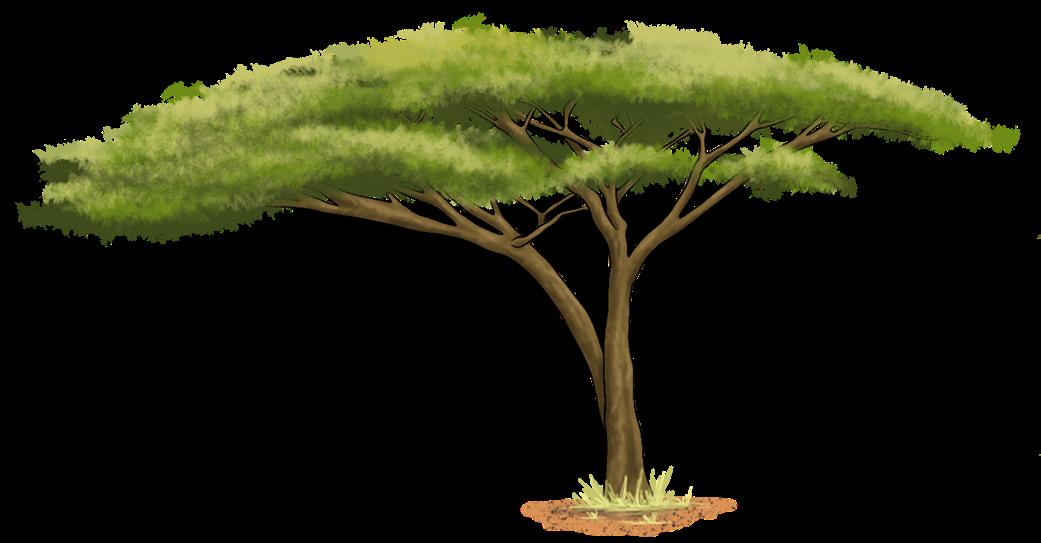Design of bio-fences

a) Living fences with wooden frames/live fence posts
Live fence posts are trees that are grown in single lines used instead of metal or wooden posts for supporting barbed wire, bamboo or other fencing materials.



Dense dead twigs and branches can also be tied upright along the live fence.
For creeper plants, creating a structure can help the plants grow around the frame and eventually form a dense, tight barrier fence.

b) Hedges
As the trees grow, branches are tied to the framework.

Living fences combined with chilli shrub fence on the outside may keep elephants out.

Live hedges are thicker, more densely spaced and are intercropped with a variety of species.
Hedges are often comprised of thorny species and may or may not be strung with wire.
The trees are planted in zigzag pattern, having a gap of 30cm- 40cm between the 3 to 4 rows.








Digging trenches with bio-fences
A system of trenches improves water infiltration and increases root growth.

The trenches aid in plant recovery while minimizing the labour work.

Border trenches should measure a width of 50 cm for single rows, 80 cm for double rows, and be 60 cm deep.
See Trenches for more information.
2. 3040 cm
Examples of Common trees used
Location; Sri Lanka

Thorny plant species work best to form live barriers and hedges as the thorns may cause pain to elephants.
1. Palmyra palm trees

Palmyra repels elephants with razor-sharp edges that grow on the trunk.
It involves planting four rows of seeds in a zig-zag pattern with 5-6 feet between each tree planted and approximately 8 feet between rows.

It takes approximately eight years for palmyra plants to reach full maturity and be at a point where they can function as a thick spikey bio-fence (Stearns, 2014).
5-6 feet
Another long-term deterrent fence must be used for the time being while the trees are growing.
The Palmyra fences can survive extreme weathers such as droughts, forest fires, and live in any type of soil.
This tree species produces that can be sold for additional income for the
Farmers can use the leaves for fuel and thatching roofs, walls and mats, and weaving baskets.


TOP TIP
Read more on: Palmyra Bio Fencing: a sustainable solution to resolve human elephant conflict in Sri Lanka. Practical Action Sri Lanka.

YouTube links: - https://www.youtube.com/watch?v=aoASL_IqGAE - https://www.youtube.com/watch?v=oLN3RVCFQzg










Tree
for more
See
Protection
To ensure elephants do not feed on the fruits, cover the tree trunks with dung paste or build a sharp rock barrier around the trees. 3.
3. Acacia species





Species such as Acacia brevispica, Acacia nilotica, Acacia tortilis can be grown as biofences.


2. Thorny Bamboo
They grow fast and have other uses such as- house construction, thatching of roofs, weaving baskets, furniture, etc. that can be sold for additional income.


Bamboo skins are also weaved into barriers, which are later sealed with chilli and cow dung paste

Elephants like to feed on the leaves of Acacia trees. You can protect your trees using various methods such as hanging beehives or applying dung paste.


See Tree Protection for more





 See Chilli Deterrents and Tree protection for more on dung paste
Acacia brevispica
Acacia tortilis
See Chilli Deterrents and Tree protection for more on dung paste
Acacia brevispica
Acacia tortilis
4.
Acacia nilotica
4. Commiphora spp
Trees such as Commiphora africana grow well in dry lands, providing medicinal, food and various other uses.


A post cut from a mature tree can be re-planted in the soil and it will re-grow into a new tree.

Some Commiphora species such as Commiphora Jacq are favoured by elephants and in some areas the trees are destroyed in great numbers, so be sure to understand which species you are using.
For example, in the Mapungubwe National Park, in Northern Limpopo Province, South Africa, elephants have severely damaged these trees. Often the very old trees are targeted and almost destroyed completely.
Holscher, B. (2011). Commiphora. Plantz Africa. http://www.plantzafrica.com/plantcd/commiphora.html
5. Citrus fruits- lemons & orange


The Orange Tree Barriers: In Sri Lanka, Project Orange Elephant is an innovative initiative put forward by the Sri Lanka Wildlife Conservation Society (SLWCS) in the year 1995. They theorized that Asian elephants avoid citrus fruits.

They approached the Dehiwala Zoo and conducted feeding trials on elephants by offering different foods such as carrots, bananas, cucumbers and orange.
Elephants avoided the orange leaves, while eating the other food.
Orange trees mask the smell of crops and deliver a natural deterrent to prevent elephants from raiding farms, hence, reducing the chance of conflict.
Mature citrus trees are tall enough that the elephants won’t trample them.
The fruits from citrus trees can be used to make pickles, or sold in the market by the farmer.


Sisal












Agave is a fibre yielding drought tolerant plant that grows well on drylands.
Cactus and similar plants are good for dry, arid climates where other types of plants have difficulty surviving.

5.
Bio-fences act as windbreakers, protecting soils from soil erosion, which overall increases crop yields.

You must know which tree species will grow well in the weather in your environment.














Make sure you are not blocking important wildlife and elephant corridors This will increase conflict and force elephants to enter in your farms.
Use combined fence barrier methods while the seedlings are still maturing.
See Protecting Schools & Compounds for more on Bio-fences.

Protect your trees from debarking by elephants- see Tree Protection.

Cost effective, as compared to other walls such as electric fences and stone walls. Termites will not attack living trees.

It takes a long time for trees to mature and become effective.
When relying on bio-fences as farm barriers, there must be consideration on long-term landuse planning and advice from informed wildlife advocates and rangers in order to place fences in appropriate areas.
The fences must be weeded two or three times during the first year after planting, to reduce competition from weeds.
Seedlings require lots of and attention
Medicinal plants such as Neem and African cherry can also be grown within live fences.(Elevitch and Wilkinson 2000).


Some tree species omit smells that elephants do not like, which can be used to mask the smells of palatable crops.

Always consider using organic/natural pest control, when necessary.

Be careful when selecting spcies like bamboo to use as a living fence, as they can easily spread out of control if they’re not carefully maintained.
Strengthens and enriches soils.



It is environmentally friendly. Moderate maintenance required to remove weeds.


See Crop Choice & Kitchen Garden Practices
If not taken care of, the seedlings will die in the initial stages.

Giribawa Elephant Bio Fence. Regenerative Organic Sri Lanka.
Credits and Disclaimer:
We have collected the information above from multiple sources that are sourced throughout the document. This manual is not extensive. The learn more and explore about Bio-fences and Walls/Barriers, see References Some original words commonly used have been simplified for easy understanding.

Save the Elephants advises caution with all the information collected and presented in this toolbox. Further research may be required before each site-specific implementation.









* Save the Elephants is not liable for any costs, damages or injuries incurred by the use of these methods or information.

Produced by Save the Elephants www.savetheelephants.org
Heath Made in Kenya 2023
Illustrations by Nicola
PROS + cons -
6.
TIPs









 Mishra, S., Vasudevan, P., & Prasad, S. (2011, June). Biofencing- an eco friendly boundary wall.
Mishra, S., Vasudevan, P., & Prasad, S. (2011, June). Biofencing- an eco friendly boundary wall.

























































